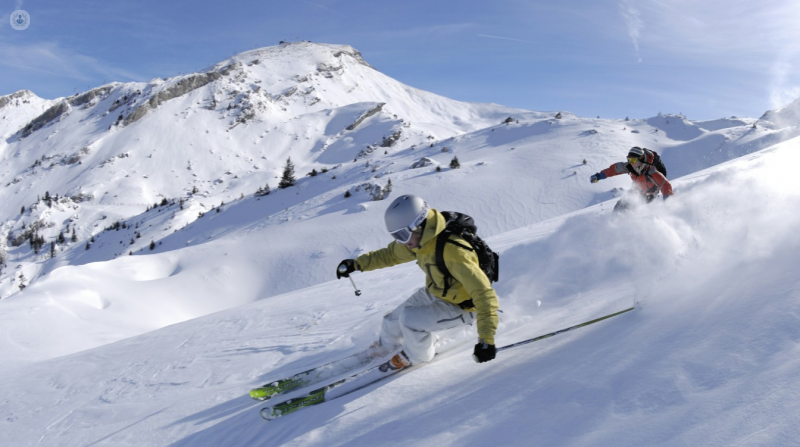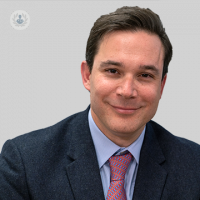Skiing injuries to the shoulder: snow laughing matter!
Escrito por:Shoulder injuries are a common occurrence among skiers and snowboarders. We asked experienced orthopaedic surgeon Mr Ioannis Polyzois how these injuries happen, how they can be treated, and what steps you can take to avoid skiing injuries.

How do skiing injuries to the shoulder happen?
Direct traumatic falls are the most common cause. This can occur due to pole planting during skiing, particularly as the result of a fall or collision when the hands are caught in the poles. Aerial manoeuvres during snowboarding can also cause falls. Shoulder injuries can also occur by simply falling on an outstretched hand.
Skiing injury and snowboarding injuries are more common during the winter season. Injuries can range from bone fractures to soft tissue injuries. The most common injuries are fractures of the collar bone, (clavicle) and humerus (upper arm) and dislocations of the shoulder, (glenohumeral joint or the AC joint), together with injuries to the rotator cuff tendons, i.e. rotator cuff sprains or rotator cuff tears.
How are they commonly treated?
A thorough history from the injured individual as well as a thorough clinical examination should be undertaken. If we are dealing with a shoulder glenohumeral joint dislocation, there should be a skilled individual at the ski resort who is knowledgeable enough to be able to reduce an acute glenohumeral dislocation, relocate the shoulder joint and provide basic splinting to humeral fractures.
An appropriate mobilisation device such as a poly sling or broad arm sling should be applied as soon as possible. Plain X-rays are usually undertaken in the ski resort in an attempt to evaluate the diagnosis and the exact location and displacement of a fracture. If there is access to an ultrasound, MRI, or CT scan that would be ideal. Occasionally, surgery can and will be undertaken in the ski resort. However, most of the time patients return home for advice and treatment.
Essentially, the treatment depends on the diagnosis:
- Clavicle fractures may be treated non-operatively or with surgery, depending on the degree of displacement of the injury.
- Similarly, glenohumeral joint dislocation may be treated operatively or non-operatively depending on the individual case.
- AC joint dislocation injury may be treated operatively or non-operatively depending on the findings and concomitant injuries.
- Rotator cuff sprain may well be treated non-operatively with ongoing physiotherapy management.
- Rotator cuff tears or full thickness tears will need to be managed with arthroscopic shoulder surgery in the form of rotator cuff repair. It is crucial that we see such patients following a significant skiing injury in 24-48 hours in our clinic.
What can I do to protect my shoulder while skiing?
It is very important, apart from knowing the correct technique, to take appropriate lessons to strengthen all the muscles of the upper and lower limbs to make sure they do not become tired when skiing. It is important for skiers and snowboarders not to exceed their comfort zone in either speed or technical challenges. They should be in control and be prepared to slow down and stop to avoid collisions with other people on the slope.
Snowboarders are more prone to sustaining injuries due to falls on the hands and there needs to be a general pre-season conditioning programme and familiarity with the equipment. One needs to be knowledgeable about how to use everything appropriately and ensure everything is working optimally.
Alcohol and drug use should be avoided. Extreme caution is advised with regards to weather conditions.
You have to make sure your boots fit well and the bindings can release appropriately. It is essential to be well prepared and have good strength in all of your muscles, especially in the lower limbs, including hamstrings and quadriceps.
As with any athlete, skiers and snowboarders should stretch properly before and after activity.
Can ski injuries recur?
When an unfortunate event such as a skiing injury to the upper limb occurs, the best thing one can do for their body is to rest and recuperate initially, either for a few weeks or a full season. It is important to follow the physiotherapist and doctor’s advice on progress and healing. Failure to do so can lead to even longer recuperation and permanent injury.
Injuries can recur, but with proper rest, conditioning, and treatment of the initial underlying injury, proper restoration of strength should be possible.
If you need specialised treatment, visit Mr Polyzois’s profile to book an appointment.



